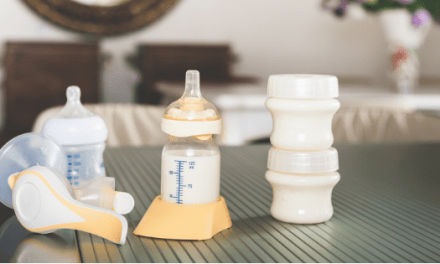During pregnancy we all have the desire to prepare as much as possible. You likely spent lots of time researching and putting together the perfect registry, setting up and organizing a Pinterest-worthy nursery, taking a childbirth class, and reading as much about every symptom possible.
In particular, many mamas spend so much time preparing for the birth they want, an event (while totally important) only lasts one day! These same mamas have goals of breastfeeding their babies for at least 6 months, a year, or even beyond. Yet, so little time is spent preparing to reach that goal.
Let?s change that today. Here you?ll find the best advice for preparing for breastfeeding before baby arrives.
1. Learn the basics of breastfeeding:
Where to start? By learning as much as you can about the basics of breastfeeding before you?re due. As a first time mama you probably don?t know a lot about breastfeeding, what a good latch looks like, or the basics of milk production.
Learning some breastfeeding 101 before baby arrives is going to give you a serious advantage. Breastfeeding is something that we expect to be second nature, but actually comes with a steep learning curve for both mama and baby.
Learn how to latch baby and what makes a good latch
The fact that my baby wouldn?t just be able to attach themselves to my nipple never even occurred to me before my first was born. In reality, it actually takes quite some time for your baby to learn the skill of latching independently.
Furthermore, if baby doesn?t have a proper latch you can suffer from painful lacerations, sores, and milk supply issues. Your baby also might have a hard time extracting enough milk to properly gain weight.
So, what makes a good latch?
- Baby should have all, or most of the areola in their mouth
- Their lips should be splayed out
- Baby?s chin should be against your breast
- Baby?s nose should be free for breathing, not up against your breast or body
And the steps to getting this proper latch:
- Control baby?s head and aim their nose (not their mouth) toward your nipple
- Wait for them to tilt their head back and open their mouth
- As soon as their mouth is wide, gently smush their mouth onto your nipple
- Once their mouth is around the nipple you may need to use your finger to curl their lips out
Know the breastfeeding positions and when to use them
Next, get yourself familiar with the most common breastfeeding positions. Knowing different options and the right time to use them will make your life a lot easier.
For example, certain positions are better to use with a newborn because they give you greater control of promoting a good latch. Others are great to use later on when baby can latch independently.
The most common breastfeeding positions are:
- Cradle hold
- Crossover hold
- Football hold
- Laid-back position
- Side-lying position
- Upright breastfeeding
Understand newborn feeding patterns:
This is another aspect of breastfeeding that takes a lot of first time mamas off guard. To get your breastfeeding journey started right and build a proper milk supply it is essential that you nurse your baby on demand.
What does this mean? You will quite literally be nursing around the clock. I was genuinely shocked at the amount of time I spent nursing in the first 4-6 weeks. At a minimum, you will be nursing every 2-3 hours, but in many cases it is more frequent than that. At about 15 minutes per side, that?s 30 minutes per feeding. Well, I?m thinking you get the picture.
Mama, I am not telling you this to discourage you and dissuade you! I just know from experience that going into breastfeeding with realistic expectations is going to increase your odds of success.
Looking to take this learning to the next level?
This is a great start on the basics of breastfeeding, but the nuances of how milk supply works, what it?s like when your milk comes in, how to actually get the latch I described above and more can get pretty dense.
For this reason, online breastfeeding classes like Milkology are a must for any first time mama with the goal of breastfeeding. It?s taught by a lactation consultant and covers all of the basics of breastfeeding, as well as more in depth concepts to give you a huge advantage to reaching your breastfeeding goal.
2. Be aware of common breastfeeding problems in the first week
After you get over the hurdle of the first ~6 weeks, breastfeeding will become second nature. You?ll enjoy an incredible bond with your baby and you?ll feel like a pro. However, getting to that point is going to take some determination. This is because of the breastfeeding problems that often crop up right from the start.
Breastfeeding problems like:
Breast engorgement: in the first few days of breastfeeding your baby is getting colostrum, then between 3-5 days postpartum your real milk comes in. This is often accompanied by extreme engorgement. Many mamas describe it as your breasts feeling like painful, heavy, rocks
Clogged milk ducts: when your milk comes in and engorgement occurs, many mamas suffer from clogged milk ducts because their baby is unable to adequately empty each side
Sore nipples: as baby gets the hang of the proper latch and you adjust to breastfeeding you will likely experience sore and tender nipples. A good nipple cream will really help with this
Tongue ties: this is a phenomenon where baby is unable to get a proper latch or properly extract milk due to a physiological difference involving their tongue or lips. Discovering tongue ties and working with a lactation consultant in the early days will be essential to your nursing success
3. Understand the true signs of low milk supply:
Often, new mamas make the mistake of assuming they have a low milk supply when it?s not the case. A fussy baby or baby that seems to want to nurse all the time for hours on end, which is known as cluster feeding, are not necessarily signs of a low milk supply! This behavior from your baby typically happens during a growth spurt and is essential to building your supply.
The only true signs of low milk supply are:
- Not enough wet diapers
- Baby not gaining weight
If you find yourself experiencing these symptoms, it is very important that you call your pediatrician for advice, get one-on-one support from a lactation consultant, and likely supplement if these professional deem it necessary.
4. Get your breastfeeding essentials
Another great way to prepare for breastfeeding while pregnant is by gathering all of the breastfeeding essentials. Some are must-haves and others are going to make your breastfeeding experience far more pleasant. These include:
- Nipple cream
- Nursing pillow, like the Boppy
- Nursing bras for day and night
- Breast pads
- Breast pump
- Breastmilk storage bags
- Notebook and pen to track feedings
- Nursing cover
- Book, tablet, or phone nearby (and charged)
- Insulated water (breastfeeding thirst is intense!)
- Easy to grab snacks (and the hunger is real)
5. Preparing for breastfeeding your second baby
Breastfeeding your second baby is a whole different ball game. In this case, you have an idea of what to expect and what you need to do, but nursing a newborn on demand is a whole lot trickier when you have a toddler or other kids to look after.
Best tips for breastfeeding your second baby:
- Create a portable breastfeeding basket with everything you need to easily grab and breastfeed wherever you need to
- Keep a breastfeeding pillow on each floor (one less thing to lug around)
- Have a few special and fun activities or toys your other little one gets to do only when you?re nursing baby
- Consider getting some childcare or support to help out in the first few days if possible
6. Find sources of breastfeeding support
Learning about where to turn for breastfeeding support before you?re in the throes of breastfeeding is an important way to prepare for breastfeeding before baby arrives. This way, if and when problems arise you know where to turn. Even if you don?t find yourself facing huge obstacles, I can guarantee you?ll be happy to have somewhere to turn even for reassurance that you?re doing things right.
Where can you find breastfeeding support around you?
- Find out if your pediatrician has a lactation consultant on staff
- Find out if you will have unlimited access to lactation consultants during your hospital stay
- Look up local La Leche League chapters which hold free breastfeeding support groups
- Find out if there are other free breastfeeding support groups in your area
- Ask at your next prenatal appointment if they have information about breastfeeding support around you
- Invest in a breastfeeding resource now, like Milkology, to learn what you can ahead of time and have a go-to in the first few weeks for clarification and reassurance
7. Prepare your breastfeeding diet ahead of time
The most important things you can do to build a proper milk supply are nurse your baby on demand, stay properly hydrated, and get enough calories. Yes, these could be empty calories in the form of sugary and starchy snack foods.
However, if you want to succeed at breastfeeding and get back to your pre-pregnancy weight, the best plan of attack is to eat plenty of calories (2500+ per day), but make sure these calories are coming from highly nutritious, real foods.
The easiest way to make this a reality is to stock your freezer ahead of time with homemade, healthy meals. Meals that can be dumped in the crock pot, popped in the oven, or heated in the microwave will be your saving grace with a newborn around.
8. Preparing your body for breastfeeding
A lot of new mamas think they need to do something to their bodies to prepare for breastfeeding. But really, your hormones know what they?re doing throughout pregnancy to make sure you are ready and well prepared for the job.
Starting very early in pregnancy your body begins to produce colostrum, baby?s first food. Your nipples have probably changed shape and color to make it easier for baby to see and latch. In short, trust that your body knows what to do!
So, do you need to prepare your breasts/nipples for nursing?
No! It is a myth that you need to toughen your nipples up to handle breastfeeding. Experts agree that you absolutely should not scrub or rub your nipples in an effort to ?toughen them up?. In fact, irritating your nipples before breastfeeding even begins will probably make it more painful from the start (source).
Set yourself up for success by preparing for breastfeeding before baby arrives, mama
With these tips, you now know there are plenty of things to do while you?re pregnant to get ready for breastfeeding. Taking the time to arm yourself with breastfeeding knowledge, resources, and essentials will go a long way in meeting your nursing goals. With determination and the right preparation ahead of time you will rock this mama!












